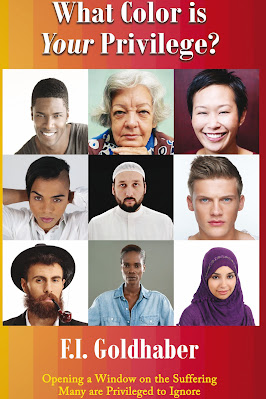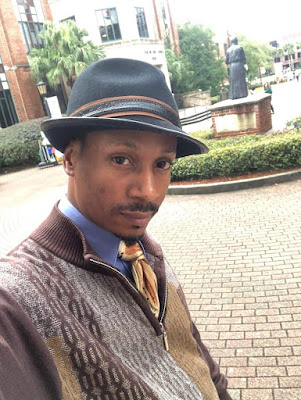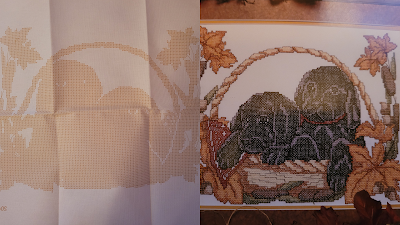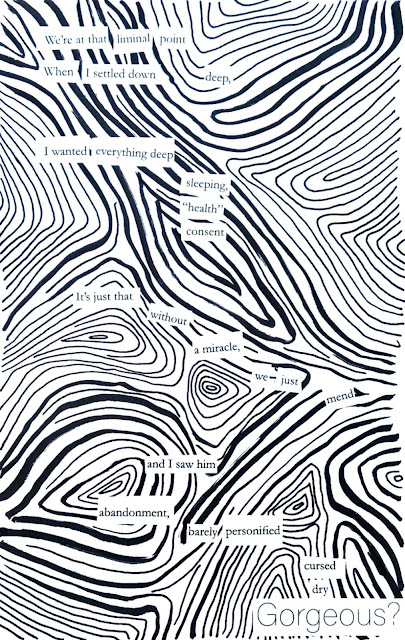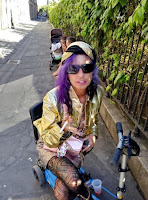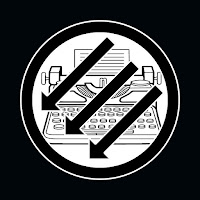Handy, Uncapped Pen: What was the most difficult thing about writing this book?
F.I. Goldhaber: I didn't "write" this book. I compiled poems that were written over a period of eight years. That said, the most difficult part of putting it together was figuring out the best order for the poems and that kept changing as I added more poems.
HUP: How long did What Color is Your Privilege? take to write/organize?
Goldhaber: I first started putting the collection together (and came up with the title) five years ago. At that time it included 20 poems. In a year it had almost doubled in size and I began sending it out to publishers for consideration.
About a year after that, John Warner Smith, who would be named Louisiana State Poet Laureate two years later, hit up the email list of contributors to Black Lives Have Always Mattered, A Collection of Essays, Poems, and Personal Narratives Edited by Abiodun Oyewole published by 2Leaf Press (in which he and I both had poems). He sought blurbs for his fifth collection—which eventually became Our Shut Eyes, devoted to racial history and contemporary issues of race in American society—with an offer to reciprocate.
Of Our Shut Eyes I wrote, quoting one of his poems, that Warner "plays the 'old familiar song, an American song of race, hate, and rage' for new audiences."
Warner described What Color is Your Privilege? as "a book-length blues song decrying racial, gender, religious, and sexual intolerance in America."
While I submitted the book, it continued to grow. Each publisher got a slightly different compilation as I added new poems I'd written and sometimes new versions of previously unpublished poems (I don't consider a poem to be in its "final form" until it's published). I even added poems after Left Fork accepted it for publication a year ago, the last two inserted in May of this year, for a final total of 72 poems.
"But, does anyone hear my words? Do
they heed my warnings? They sit and nod,
sometimes buy my books."-
from "Poetry "HUP: Writers who are activists can often feel like their words are useless when it comes to inspiring change. What would you say to those writers?
Goldhaber: That poem actually started out as my introduction when I read poetry at live events and gradually morphed into the introduction to What Color is Your Privilege?
To answer your question, I would say keep writing. Keep submitting. If you only reach one person, if your words influence only one reader to change how they think/approach the world, consider that a success. (And you never know which poem will touch which reader when.) You never know when (and may never learn about) one person will make a difference, however small, that will impact another (or many others) in positive ways.
What Color is Your Privilege? received 22 explicit rejections and 12 implicit ones before it found its perfect home (i.e. someone who loved the book and was excited to publish it) at a press I'd only known about as the indicia on books by colleagues. (I never saw Left Fork on a list of publishers seeking submissions, it has a very narrow focus, but turned out to be a splendid fit.)
Although every one of the 72 poems had been submitted for consideration to at least one publication, only 56 were published previously and almost all received at least one rejection.
Perseverance is key in publishing and protests.
HUP: You talk about passing as white in "Little Old White Lady". How has passing influenced your activism?Goldhaber: Passing allows me to observe the behavior of those for whom I intended this book—privileged, liberal, white, abled, cis people—when they're not performing (and I mean that in the literal sense) as allies and to better understand how liberals contribute to the problems of systemic racism, ableism (always a tool of white supremacy), and other forms of oppression. (Liberals are today's white moderates about whom Martin Luther King Jr. warned us in his Letter from Birmingham Jail: "more devoted to 'order' than to justice".)
It also gives me the privilege of using that assumption of whiteness to advocate for, and when appropriate, interfere on the behalf of those who are not as I did in the incident related in that poem.
If the service is free,
you’re not the customers,
your data’s the product.
-from "Products for Sale"HUP: I think these lines are so important, especially for marginalized folks and activists when so much can be used (not just for marketing) against them in various ways. Do you have any tips for those who have to be "present" online for one reason or another but want to be cautious? Is controlling what you share and not clicking ads enough?
Goldhaber: It's a start. My best advice is to treat everything online with the utmost paranoia (just because you're paranoid doesn't mean they aren't out to get you) and to always give as little information as possible. Every single entity you share personally identifying information (PII) with has a) the potential to be hacked making that information available online for the world to access and b) the ability to share your information with entities that will try to sell you things you don't need at best and seek your destruction at worst. In addition:
- Don't share your phone number, DOB (use a fake one if it's required e.g. on Facebook), Tax Identification Number (including your Social Security number), home address, etc. anywhere you don't have to, but especially social media accounts, posts, or "private" messages. Even "security questions" asking you for seemingly innocuous information like your first pet or where you went to school, are data gathering traps. Make stuff up.
- Do not take quizzes, sign petitions, or play online info games. Those are at best data gathering tools and at worst PII thefts (notice how often the questions mirror those "security" questions).
- Just because someone asks you for information, doesn't mean you're required to provide it (e.g. medical offices and insurance companies ask for your TIN/SSN). Do not give it to them.
- Don't use your phone to log into social media or access your financial information, doing so shares that information with Google or Apple (depending on whose OS you use) plus the app you're using and whoever it sells your data to.
- Remember, anything you post on social media, including posts/messages marked private or deleted are never private.
- Turn off tracking on your phone and use tracking blockers in any browser.
- Don't use the same email address for social media that you use for your financial or personal correspondence (IMO, everyone should have at least three email addresses and a free gmail or similar type account should only be the one used for social media).
- Don't log into any accounts, as you're often encouraged to do, with Facebook, Google, or any other social media, because that shares your information with those entities and they will use it. Always create a new, separate, unique account.
- Use unique, secure passwords (12 or more characters in an incomprehensible combination of letters, numbers, and symbols) for each place you do log into. Invest in a password "safe" to track your passwords (and whatever fake birth date or fake answers to security questions you gave), one that stores its data on your machine not in the cloud, and keep an encrypted copy on a separate storage device.
- Don't store your data, especially PII, in the cloud.
- There's plenty more, of course. And if you haven't been doing these things, The Smart Girl's Guide to Privacy: Practical Tips for Staying Safe Online by Violet Blue can help you mitigate damage already done.
Hate speech is not free speech when it drowns
out the voices of others; when it’s
used to harass those with darker skin;
when it incites violence, murder.
HUP: I can't tell you how many times I've heard that we have to allow hate speech because it's part of our list of rights and not letting people say what they want is a "slippery slope". What is your response to people who say that?
Goldhaber: I don't tolerate the intolerant.
The First Amendment to the U.S. Constitution only guarantees that "Congress shall make no law … abridging the freedom of speech". It doesn't prevent private entities (such as social media companies) from regulating what people are allowed to publish on their platforms, it doesn't require anyone to listen/read hateful words, and it doesn't guarantee freedom from the consequences of one's words (including being fired, shunned, and/or ostracized for hate speech).
Media awarding objective weight to both sides, equating fascist hate speech with leftist calls for change while ignoring the danger of the former and the validity of the latter; comparing violence, death, and civil rights evisceration by the right to protest vandalism from the left, helped create the mess we're currently in.
Words can kill. Hate speech is used to rile up the right, empowering them to doxx, attack, and murder marginalized people and those who fight back (or deliberately harass them into committing suicide). The list of people killed by online hate speech (including Faux News and other so-called "news" media) grows longer every day. People radicalized by "reporters" and "commentators" who get rich pushing conspiracy theories, projecting pedophilia plots, and lying about who's actually interfering with voting rights, education, and the courts, murder children and adults daily.
HUP: I found your poem "Gender Blending Fashion" to be such a sweet, lovely piece about the permission to express gender in whatever way feels true to someone. Why do you feel people try so hard to "police" other people's fashion choices?
Goldhaber: Policing other people's fashion is very much a part of binary thinking, and an attempt to impose cultural gender constructs on anyone who eschews them. Men can't wear skirts (unless they're kilts) and women must wear makeup and more "femme" clothing. This, of course, ignores the fact that for a time the height of male fashion included makeup, wigs, frilly clothing, and pointy-toed high heels.
Gender is a cultural construction of beliefs/behaviors assigned to people based on their sex. It varies significantly throughout time, across cultures, and controlled by class considerations.
It's ironic that people who claim to be feminists, a movement partially about throwing off gender-restrictive roles, are so critical about enforcing binary, gender-based restrictions. (Which is why I refuse to allow them to claim they are feminists—they're mostly Nazis/white supremacists since that's where fascism starts—eliminating Queer/Trans folk and strictly enforcing gender roles.)
HUP: If for-profit prisons ended tomorrow, what do you think would change in the "justice" system?
Goldhaber: The entire "justice" system is "for-profit" with the sole purpose of furthering oppression of marginalized people. Look at what's considered criminal and what isn't. For example:
- Police-reported "property crime" doesn't include employer wage theft (~$50 billion annually) more than triple all theft "crimes" complied in "crime rate" statistics.
- Police-reported "property crime" also doesn't include police civil forfeiture seizures, a large percentage of which are not legal, which steal almost six times as much as all reported burglaries combined.
- Police-reported "violent crimes" don't include several million physical and sexual assaults committed by police and jail/prison guards each year.
The
Thirteenth Amendment to the U.S. Constitution only partially eliminated slavery and involuntary servitude. Slavery is still legal in this country "as a punishment for crime whereof the party shall have been duly convicted". Of course, the Constitution doesn't define those crimes and states in the south quickly passed and still enforce
Black codes created specifically to maintain the slave labor force.
Those Black codes have become the basis of our entire so-called "justice system." And, because oppressing and marginalizing people is inextricably intertwined with capitalism, the U.S., with the highest rate of locking up its citizens in the entire world, has an extremely lucrative carceral system. As a result, ending it is fought mercilessly by those who benefit from it. This includes police who make six-figure salaries with all kinds of benefits (health care, time off, generous lifetime pensions after 20 years or less, etc.) and practically unlimited budgets to purchase weapons, vehicles, and other toys bullies like to play with as well as well-staffed public relations departments created to maintain the false narrative that cops improve public safety; District Attorneys who are always better compensated than public defenders; and judges (who often start out as DAs, make exorbitant salaries with large benefit packages, and receive almost no scrutiny about how they operate). All three of these groups often ignore the law they claim to care so much about and/or twist it to serve their own purposes and increase their personal wealth.
The entire punitive cash bail system is a huge profit center as are court fees; fines; contracts to provide meals, health care, clothing, and other services at jails/prisons; monitoring costs (e.g. the person required by a court to wear an ankle bracelet is also required to pay an exorbitant amount of money to "rent" it and billions are spent on cameras and other systems observing the incarcerated); etc.
All of these costs are paid for by taxpayers and the incarcerated at the expense of medical care, food, housing, education, childcare, arts, recreation, improved infrastructure, etc.
Although combined we outnumber our
oppressors, as long as we allow
them to divide and conquer we will
never succeed in breaking our chains
HUP: What do you think is the most effective tool they use to keep us divided?
Goldhaber: Othering. By artificially constructing hierarchies and divisions—whether based on skin color, religion, education, type of employment, gender, immigration status, language spoken, ability, sexuality, etc.—a small number of wealth hoarders pit the rest of us against each other discouraging us from working together to fight their oppression. They project their crimes and grift (grooming/sexual exploitation of children, drug use, theft, government welfare, price gouging, etc.) onto others and create fake issues (abortion, LGBTQ recruiting) to enrage and embolden people who will believe their lies and vote for their sycophants.
Poverty is a policy choice and many acts considered criminal are in fact people trying to stay alive. The cash bail system imprisons poor people who have not been (and may never be) convicted of a crime (often costing them their jobs, homes, custody of their children, etc.) while people with money (if they are arrested at all) are immediately freed.
The federal minimum wage hasn't budged from $7.25 for thirteen years, but the purchasing power of that pittance had gone down almost $3 at the beginning of the year. In that same time period, CEO compensation shot up 54 percent and corporate profits skyrocketed, fueling inflation (but notice inflation is being erroneously blamed on union organizing that has obtained miniscule wage increases) making that already-unlivable wage worth even less.
~*~
Biography: F.I. Goldhaber's words capture people, places, and politics with a photographer's eye and a poet's soul. As a reporter, editor, business writer, and marketing communications consultant, they produced news stories, feature articles, editorial columns, and reviews for newspapers, corporations, governments, and non-profits in five states. Now paper, plastic, electronic, and audio magazines, books, newspapers, calendars, broadsides, and street signs display their poetry, fiction, and essays.
http://www.goldhaber.net/

.jpg)

